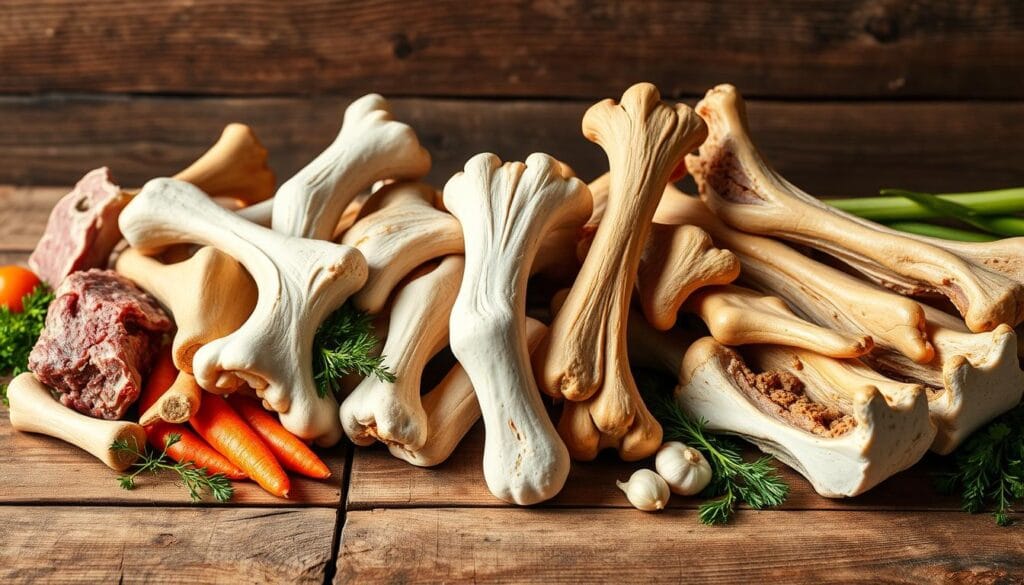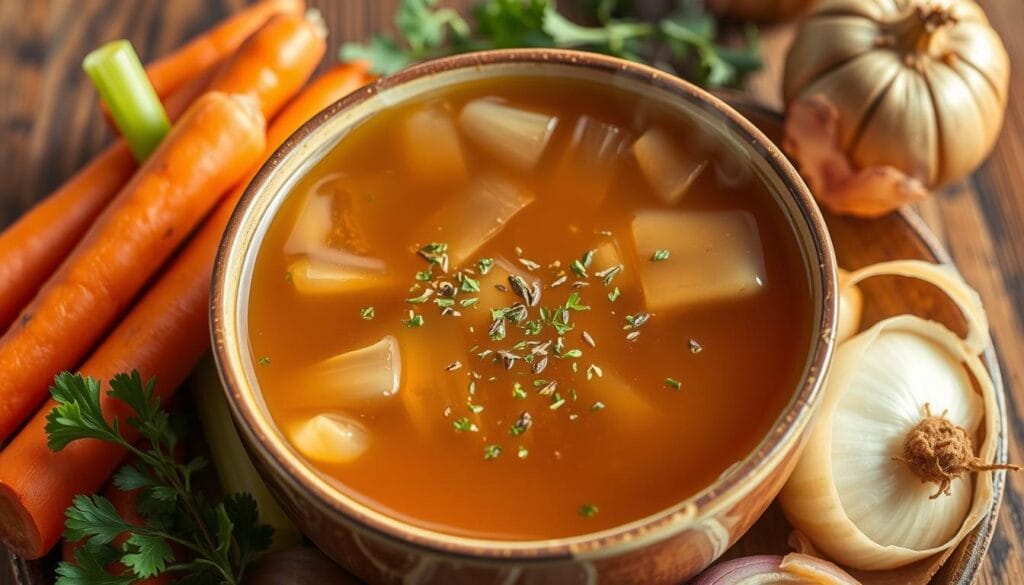Growing up in my grandmother’s kitchen, I learned something special. The heart of every great soup starts with a magical ingredient: a rich, meaty soup bone. Those tender beef bones simmering in a pot were more than just ingredients. They were culinary treasures that could turn simple dishes into amazing meals.
A soup bone is more than a simple kitchen staple. It’s a flavor and nutrition powerhouse that can take your cooking to the next level. Whether you’re making a hearty bone broth or a satisfying stew, soup bones add unmatched depth and richness.
Choosing the right beef bones opens up a world of flavor and nutrition. These bones are not just about taste. They’re also full of nutrients, collagen, and minerals that can improve your health and satisfy your taste buds.
Key Takeaways
- Soup bones are essential for creating rich, flavorful dishes
- Beef bones provide exceptional nutritional benefits
- Bone broth offers complex flavor profiles
- Quality soup bones transform basic recipes
- Cooking with bones connects us to traditional culinary techniques
Understanding Soup Bones and Their Basic Characteristics
Soup bones are key in making tasty meat stock. They’re not just kitchen scraps. They’re packed with nutrients that can boost your cooking.

Marrow bones add a special flavor and nutrition to dishes. Both home cooks and chefs love them. Knowing about them can make your cooking better and healthier.
Different Types of Animal Bones Used in Cooking
- Beef bones: Rich in collagen and minerals
- Chicken bones: Light and perfect for delicate stocks
- Pork bones: Offer a distinctive, robust flavor
- Lamb bones: Provide a unique, intense taste profile
Anatomy of a Quality Soup Bone
A top-notch soup bone should have these features:
- Visible marrow in the center
- Fresh, clean appearance
- Minimal external fat
- Robust bone structure
| Bone Type | Nutritional Value | Best Used For |
|---|---|---|
| Marrow Bones | High in minerals, collagen | Rich stocks, soups |
| Knuckle Bones | Rich in gelatin | Slow-cooked dishes |
| Neck Bones | Good protein content | Hearty stews |
Fresh vs. Frozen Soup Bones
You’ll find fresh and frozen soup bones. Fresh bones taste better, but frozen ones are more convenient. Bone nutrition stays the same with both, if handled right.
“The secret to an exceptional meat stock lies in choosing high-quality bones.” – Professional Chef
Knowing about bone characteristics helps make tasty, nutritious meals. Your family will love them.
The Nutritional Power of Bone-Based Broths

Bone broth is more than a health trend. It’s a nutritional powerhouse with essential nutrients that can change your diet. The bone broth diet is popular for its health benefits and nutrient-rich profile.
Collagen-rich broths have a special mix of minerals, amino acids, and proteins. These nutrients support your overall health. Your body can easily absorb them, making bone broth a great nutritional supplement.
- Provides essential amino acids for muscle repair
- Supports joint health and flexibility
- Boosts immune system function
- Promotes healthy skin and hair growth
The main nutrients in bone broth are:
| Nutrient | Health Benefit |
|---|---|
| Collagen | Supports skin elasticity and joint health |
| Glycine | Improves sleep quality and supports metabolism |
| Minerals | Strengthens bones and supports cellular function |
“Bone broth is liquid gold for your health, delivering nutrients in their most absorbable form.” – Nutritional Experts
Adding collagen-rich bone broth to your diet is a natural way to support your body’s nutritional needs. The bone broth diet is a simple yet effective way to boost your wellness with traditional, nutrient-dense food.
Essential Guide to Selecting the Perfect Soup Bone
Choosing the right beef bones can make your cooking amazing. Whether it’s a rich bone broth or a hearty soup, picking the right bones is key. It’s all about getting the best flavor and nutrition.
Finding top-notch beef bones takes knowledge and careful picking. Your cooking’s success depends on the quality of your ingredients.
Where to Source Quality Bones
- Local butcher shops specializing in grass-fed beef
- Specialty meat markets
- Farmer’s markets with local ranchers
- Online meat delivery services
- High-end grocery stores with dedicated meat departments
Signs of Fresh and High-Quality Bones
When picking beef bones or marrow bones, look for these signs:
| Quality Indicator | What to Look For |
|---|---|
| Color | Creamy white to light pink |
| Texture | Smooth, without excessive bruising |
| Smell | Neutral, fresh meat aroma |
Storage and Preparation Tips
- Refrigerate beef bones immediately after purchase
- Use within 2-3 days of buying
- Freeze if not using immediately
- Thaw in refrigerator before cooking
- Rinse bones under cold water before preparation
“The secret to exceptional bone broth lies in selecting the right bones and handling them with care.” – Professional Chef
By following these tips, your marrow bones and beef bones will add amazing flavor and nutrition to your dishes.
Traditional Methods of Cooking with Bone Marrow
Cooking with bone marrow is a tradition found worldwide. It shows how simple soup bones can become amazing dishes. This is thanks to the rich cultural practices of making meat stock and bone broth.
Different cultures have their own ways of cooking bone marrow. This shows its amazing versatility:
- French cuisine loves bone marrow, often roasted and served with bread
- Asian cooking adds bone marrow to nourishing bone broth soups
- Middle Eastern traditions use marrow in hearty stews and slow-cooked dishes
Traditional cooking methods stress the need for slow cooking. Getting the most flavor and nutrition takes patience and knowing how to manage heat. Low and slow is key when using soup bones.
“Bone marrow is liquid gold in the kitchen – packed with nutrients and deep, complex flavors.” – Chef Michael Ruhlman
Your cooking technique is crucial when working with bone marrow. Roasting, simmering, or braising can bring out different flavors in your meat stock. Chefs say choosing bones with visible marrow gives the best results.
Learning these traditional cooking methods turns simple soup bones into culinary wonders. These dishes connect us to cooking traditions passed down through generations.
Creating Rich and Flavorful Bone Broth at Home
Making delicious bone broth at home is simple. It’s great for cooking fans and health buffs alike. Creating your own slow cooker recipe for bone broth can change your cooking game.
Creating bone broth needs patience and the right steps. The goal is to get the most flavor and nutrients from your bones.
Essential Steps for Perfect Bone Broth
- Choose high-quality bones from grass-fed animals
- Roast bones for better flavor before simmering
- Cover bones fully with cold water
- Simmer on low heat for 12-24 hours
- Strain and store in airtight containers
Seasoning and Aromatic Enhancements
The taste of your bone broth comes from the seasonings you pick. Here are some great options:
- Fresh herbs like thyme and rosemary
- Whole peppercorns
- Garlic cloves
- Onion and celery
Slow Cooker vs. Stovetop Methods
| Method | Pros | Cons |
|---|---|---|
| Slow Cooker | Consistent temperature, hands-off approach | Longer cooking time |
| Stovetop | More control, faster results | Requires more monitoring |
“The secret to a perfect bone broth is low and slow cooking” – Culinary Expert
Pro tip: For a rich, gelatinous broth, use joint bones with cartilage. Your slow cooker recipe will make a nutrient-rich liquid that boosts any dish.
Health Benefits of Incorporating Soup Bones in Your Diet
Exploring bone nutrition shows amazing health benefits. Soup bones are full of nutrients that boost your health. The bone broth diet is popular for its natural health benefits.
Your body gets a lot from eating collagen-rich bone broth. Here are some key benefits:
- Enhanced joint health and reduced inflammation
- Improved digestive system function
- Stronger immune system support
- Better skin elasticity and hydration
Protein and minerals in soup bones are great for you. The collagen rich parts help fix connective tissues. This can lessen joint pain and help muscles heal.
“Food is medicine, and bone broth is liquid gold for your health.” – Nutrition Expert
Adding bone broth to your diet gives you important amino acids like glycine and proline. These help your body heal and keep cells working right.
Try to have bone broth every week for its health perks. It’s good for athletes, people with joint pain, or anyone looking for healthy food. The bone broth diet is a natural way to stay healthy.
Learn to make Philadelphia cream cheese recipes and perfect your almond cookies.
Common Mistakes to Avoid When Cooking with Soup Bones
Making delicious bone broth needs skill and care. Many home cooks make mistakes that hurt the quality of their soup bone dishes. Knowing these common errors will help you make rich, tasty bone broth every time.
Temperature Control Challenges
Keeping the right temperature is key when cooking with soup bones. Too much heat can ruin nutrients and make the broth taste bitter. Here are some important tips:
- Start with cold water when making bone broth
- Simmer gently instead of boiling hard
- Keep the temperature between 180-200 degrees Fahrenheit
Cooking Duration Mistakes
The time you cook soup bones affects flavor and nutrient extraction. Cooking too fast or too long can result in poor taste.
| Bone Type | Recommended Cooking Time | Nutrient Preservation |
|---|---|---|
| Beef Bones | 12-24 hours | High |
| Chicken Bones | 6-12 hours | Moderate |
| Pork Bones | 8-16 hours | High |
Improper Bone Preparation Techniques
Proper preparation of soup bones is vital for getting the most flavor and nutrients. Important steps include:
- Roasting bones before simmering to add depth of flavor
- Cleaning bones well before cooking
- Picking high-quality, grass-fed or organic bones
“The secret to exceptional bone broth lies in careful preparation and patient cooking.” – Culinary Expert
Avoiding these common mistakes will make your bone broth stand out. Remember, practice makes perfect with soup bones.
Creative Ways to Use Leftover Bone Broth
Don’t let your precious bone broth go to waste! With a bit of creativity, you can turn leftover meat stock into tasty dishes. These dishes will make your cooking better.
Your leftover bone broth can be a secret kitchen tool. Instead of throwing it away, use it in these creative ways:
- Cook grains like rice or quinoa with bone broth for better flavor
- Make rich pan sauces by deglazing with bone broth
- Use as a base for quick soups and stews
- Replace water in mashed potatoes for a richer taste
For pasta fans, bone broth can make risotto luxurious. It adds depth and a creamy texture without extra cream.
“Bone broth is liquid gold in the kitchen – waste not, want not!” – Professional Chef
Here are some recipe ideas to spark your creativity:
| Dish | Bone Broth Application |
|---|---|
| Risotto Milanese | Replace water with meat stock |
| Braised Vegetables | Use as cooking liquid |
| Gravy | Thicken with bone broth base |
Pro tip: Freeze bone broth in ice cube trays for easy portioning and future use in various recipes.
Conclusion
Soup bones are more than just a cooking ingredient. They open the door to rich flavors and great nutrition. By learning about bone broth and the benefits of soup bones, you can change your cooking and health routine. They add a special touch to your meals, whether you’re following old recipes or trying new ways of cooking.
Exploring how to prepare and cook soup bones shows their amazing potential. They add important minerals, collagen, and protein to your diet. This supports your health. Whether you love cooking or are into nutrition, using soup bones can make your food taste better and be healthier.
Don’t be scared to start using soup bones in your kitchen. Begin by picking good bones from local butchers or meat markets. Try different ways of cooking, like slow cookers or stovetops. Each method brings out different tastes and makes your bone broth even better.
Keep learning about soup bones and enjoy the journey. Be patient with your cooking skills and enjoy the tasty, healthy food you make. Your meals will get better, and you’ll connect with cooking traditions that have lasted for years.
FAQ
What exactly is a soup bone?
A soup bone is a bone rich in marrow, often from beef, chicken, or other animals. It’s used to make flavorful broths and stocks. These bones are full of collagen, nutrients, and flavor compounds that make your cooking better and healthier.
How do I choose the best soup bones?
Choose fresh, high-quality bones with visible marrow. Opt for bones from grass-fed or organic sources. Beef knuckle, marrow, and neck bones are great choices. Look for bones that are clean and have minimal discoloration. Ask your local butcher for their freshest bones.
Can I make bone broth in a slow cooker?
Yes, you can make bone broth in a slow cooker. Just cover bones with water, add veggies and herbs, and cook on low for 12-24 hours. This method gently extracts nutrients, making a rich, flavorful broth with little effort.
What are the primary health benefits of bone broth?
Bone broth is good for your joints, digestion, and immune system. It’s packed with minerals like calcium, magnesium, and phosphorus. The collagen in it can also improve skin elasticity and gut health.
How long can I store bone broth?
Bone broth can be stored in the fridge for 4-5 days. Freeze it in airtight containers for up to 4-6 months. Cool the broth completely before freezing and use clean containers to keep it fresh longer.
Are soup bones expensive?
Soup bones are usually affordable, costing between $2-$5 per pound. Butchers often sell them cheaply since they’re not as popular. You can find great deals at local butcher shops, farmers markets, or directly from meat producers.
Can vegetarians use bone broth alternatives?
Vegetarians can make nutritious broths with vegetable stocks, mushroom bases, and seaweed. While they won’t have the same collagen and protein as bone broth, they’re still tasty and healthy for soups and cooking.
What’s the difference between stock and bone broth?
Stock is made by simmering bones for a short time, creating a cooking base. Bone broth is simmered longer (12-24 hours), extracting more nutrients, minerals, and collagen. It’s more nutritious and flavorful, with better health benefits.

